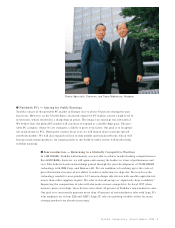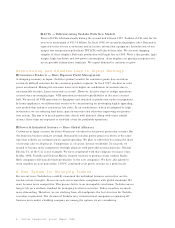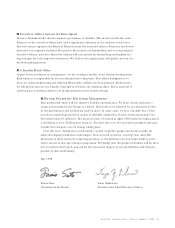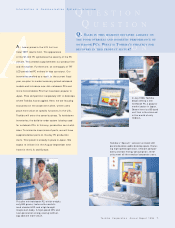Toshiba 1998 Annual Report Download - page 14
Download and view the complete annual report
Please find page 14 of the 1998 Toshiba annual report below. You can navigate through the pages in the report by either clicking on the pages listed below, or by using the keyword search tool below to find specific information within the annual report.
12. Toshiba Corporation Annual Report 1998
A.
Q.
ANSWERS
A NSWERS
ANSWERS
A NSWERS
ANSWERS
combine trench-type memories with logic circuitry. With both
DRAM and logic functions on a single chip, data throughput
efficiency is improved dramatically. We first commercialized this
in 1995 for graphic workstations. Since then, there have been
a growing number of inquiries, mainly about applications
involving imaging. We have good momentum in system LSIs.
Our “ TX System RISC” series processors, which are based on
architecture from MIPS Technologies, Inc., have been chosen as
the main processor in many widely used systems.
Q. DURING THE PAST YEAR, BIG SWINGS IN THE SUPPLY
AND DEMAND FOR LCDS CREATED A CHALLENGING
SITUATION. WHAT IS TOSHIBA’S STRATEGY FOR SHIELDING
LCD PERFORMANCE FROM THIS VOLATILITY?
Users in many industries are adopting the “ TX System
RISC” series of processors, which draw on MIPS Tech-
nologies’ architecture. Networking devices, printers,
mobile data terminals and game units are just a few of
the many potential markets.
In a breakthrough, Toshiba developed
an 8.4-inch SVGA low-temperature
polysilicon TFT LCD. Its low power
consumption and slender profile are
precisely what makers of mobile data
products are seeking.
12. Toshiba Corporation Annual Report 1998
A.
the key qualities demanded by mobile products: high resolu-
tion and low power requirements. We are working on ways
to cut costs more, even in polysilicon products. One break-
through is an internal driver IC. That means fewer external
tabs and big savings in parts and materials. The combination
of polysilicon TFT LCD technology and lower cost amorphous
TFT LCDs should yield a reliable base for generating profits.
A. We carefully examine the LCD market before approving new investments. We have concluded that
further price reductions are inevitable, since sales of notebook PCs, the largest market for LCDs, are
growing. One goal is cutting costs for conventional amorphous TFT LCDs. We are raising productivity
and yields while reducing the cost of parts and materials. Another element of our strategy is to differen-
tiate ourselves with low-temperature polysilicon TFT LCD technology. Polysilicon TFT LCDs have both of
























